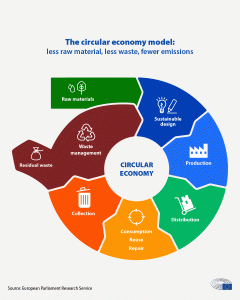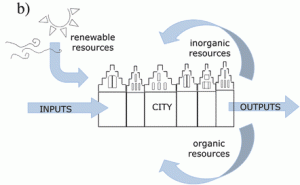
09 Apr Circular Economy & Urban Metabolism: basic principles
Circular economy is the future. And the future is now. Since the 70s, this concept has been settling and growing its presence in every narrative and professional field, especially within sustainability and architecture circles. It has had precursors (1), like the concept cradle to cradle (2) (instead of cradle to grave), regenerative design (3), or blue capitalism; but recently, due to the challenges Humankind faces when it comes to its relationship with our planet and its resources, circular economy has become a stronger, inclusive, and intersectional way to understand our production and consumption processes.
WHAT IS URBAN METABOLISM?
We can define metabolism as the group of processes and transformations which occur within a defined system, from input to output. Inputs as in those elements needed for the system to function and exist. Processes as in all the changes, transformations, transports, etc… the system executes to function and exist. And outputs as in those resulting elements post-processing that are no use for the system to function and exist, and that are, thus, expelled.
For example, we are familiar with biological metabolism. Living beings intake food / nutrients, process them within their bodies transforming them into tissues, energy, and more; and output waste. We can imagine something similar when it comes to cities: our cities require resources (water, food, materials, money, energy, trees, humans…) that feed the big urban machinery (water parks, provide shops and factories with materials, humans who pay taxes and partake in activities…) and produce waste (sewer waste, trash, energy thermal loss, population loss…).
.

Image credit (4)
We can take this concept and apply it to bigger and smaller scales. There is no blueprint for sustainable design. Solutions to our sustainable case will change over time, will replace themselves and will act on both macro and microscale. We can discuss the metabolism present in a multi-dwelling building with five hundred condos. We can discuss the national metabolism of energy production, consumption, and waste. We can discuss the global metabolism of fast-fashion chains.
But at the end, everything comes down to the same three principles: inputs, processes, and outputs.
WHAT IS TO BE SUSTAINABLE?
We usually use the term sustainable to define realities which are able to continue over a period of time (5). However, when it comes to sustainability in the way we mean it in this context, we actually intend these realities to be self-sustainable. This is, realities whose processes are able to be maintained and supported over a period of time with no outer inputs.
Once a teacher on college said, “the only thing which is really sustainable is dead”. And she was right. Everything else is just a balance between input and waste, between a system who collapses and extinguishes itself, and the repowering injections it receives to keep afloat. What is dead doesn’t need inputs, doesn’t require processing, nor produces outputs.
As we defined previously when we discussed metabolism, we refer to these realities as defined systems. This is important, for we need to have clear which boundaries the system to be studied has so we can understand the variables and exchanges it produces, and are able to predict how sustainable it is over time. The concept of sustainable requires indeed of a timeframe of study, and usually is defined about what we are trying to sustain. For example, nobody is concerned about the sustainability of the Solar System. We know the Sun will expand and devour the closer planets, we know our galaxy will collapse into the black hole who powers its center… but the timeframe of these events is so immense that for all Humankind care, it is sustainable and eternal. Nobody will claim solar panels are a finite source of energy because the Sun will be gone at some point.
As conclusion: there is no such thing as a perfect self-sustainable system. But the goal we have when striking for sustainability is to enhance and find ways to make our defined system last in time as much as possible, with the less amount of inputs and outputs. How much is as much as possible? Until we are not here to see it collapse.
LINEAR ECONOMY: FROM CRADLE TO GRAVE
Since the Industrial Revolution and the production boom it caused, with its advantages and disadvantages, consumption process followed a Linear Economy.

Image credit: (6)
Raw materials are taken (input); then they are transformed, transported, used and consumed (processed), and the waste produced (output). Of course, the ability to produce goods on a large scale became a great power up for society development, and investments in storage, transportation, industry, and more were beneficial. But the amount of waste this model of consumption brought was incompatible with a population higher every decade.
REUSE ECONOMY : REUSE, REDUCE, RECYCLE
Mid XX century, the obvious becomes visible: we cannot expect eternal growth with limited resources. Because due to that production boom, those raw materials are not as potentially endless anymore. As we said, the system that was ‘sustainable’ under XVIII century parameters, is not sustainable anymore. How would a shoe maker in London think that the leather he used would have the potential to eradicate the huge Amazon jungle for its creation? Again, the timeframe in our defined system changed the vision of it.
New ideas to make the system more efficient start to arise. The goal is clear: the inputs and outputs need to be reduced, the processes optimized. The Reuse, Reduce, Recycle ideology arrives, as an attempt to keep the system running whilst retrofitting and self-feeding itself.
CIRCULAR ECONOMY: CRADLE TO CRADLE
Following the logical next step, we arrive at the new goal: outputs need to also be inputs. Waste needs to disappear. The motto ‘the best residue is the one who is not produced’ guides this new way to understand our production and consumption system.

Image credit: (7)
Let’s rethink how our previous urban metabolism scheme would be updated with this knowledge: with the introduction of local renewable energy production, the reuse of gray waters, composting food waste, local programs for mutual aid and care, efficient public transportation… We have created such complex societies that every process is connected with so many more. So with some ingenuity when it comes to design, responsibility and sensibility when it comes to processes, and clear path of actions when it comes to give elements back into the network, we are aiming to achieve that defined system that reaches the equilibrium point in which it can be self-sustained.

Image credit (4)
We can find many examples of processes already happening that aim for this goal: composting food waste at a local scale with an additional container; installation of heat pumps; water filler stations becoming more popular; laws to standardize electronic devices (9) and expand their use lifespan…
GLOBALIZATION AND INTERSECTIONALITY
Challenges to circular economy are many, but there is one that is at the same time a detriment and an opportunity: globalization. Our society is every time more international, better connected and expansive. We are establishing the whole planet Earth as the defined system to optimize. A system composed by systems composed by systems subdivided by more systems and systems. It is an immense task to accomplish, and yet we are striking and defining guidelines and actions both on the macro-scale and the local scale.
The greatness of circular economy is that it grows with the inclusion of intersectionality, a concept that is not new, but that has gained a lot of impulse in the younger generations who are aware and fight for social and human rights. We cannot discuss circular economy without discussing public health, urban renaturalization, opportunity fairness, global warming, energy production, local ordinances and zoning, water control, imperialism and eurocentrism, Human Rights, social justice, vulnerable communities, veganism, and world hunger, capitalism…
For example, the ideology of degrowth (with a first appearance during the industrial revolution, but with a stronger presence since the 70s) is a very interesting movement that opposes the traditional capitalist ever-growing ideology and proposes that we need to aim for a smaller, better-designed system not based on the constant surplus. This ideology is not only anti-capitalist at its root but it also centers the focus on what happens on the closer scale, in the community, in the local. Because how are we to design an ever-growing system whose new inputs will constantly need to be redirected? Specially when the only goal for those inputs are the mere desire to have more inputs, regardless the overall functionality? We simple cannot.
Millenia ago, Ptolemy proposed one of the most complicated models to explain our solar system. It added new orbits within orbits, and yet with all its complexity, it failed to correctly illustrate the movement of the celestial bodies. He had it wrong from the starting point: Earth was not the center of the solar system, and everything could be fixed with a simpler model. Something similar is happening with the attempts to save the keep moving with the current production and consumption system, when we can´t confront the truth of its needed replacement. Reforms and complexities aiming to save big businesses and big companies conflict with the common good.
The transformation necessary for us to reach circular economy will require structural changes; and accept that Humankind goals of survival are not always in alignment with financial benefit goals. And still, one of the basic reasons many Governments and big companies are taking action towards a greener future is simple: it is cheaper to prevent the system from collapsing than to fix it up once it does (8).
CIRCULAR ECONOMY TAKEN INTO A PROJECT: THE SOAP FACTORY
I hope this brief article has helped you understand a little better some concepts that will be more and more common in design and every other aspect of our life. I would like to invite you to have a look at a project I worked on in college, with Circular Economy as its foundation.
LINK: SOAP FACTORY IN VILLAVERDE

Until next time!
Sources:
Cover image: Image by Freepik
(1) Qué Es la economía circular, su origen y su evolución. Bioselecta Spanish Food S. Coop. Pequeña. (2024, April 9). https://www.bioselecta.com/blog/noticias-y-novedades-sobre-alimentacion-ecologica-y-productos-bio-1/post/que-es-la-economia-circular-su-origen-y-su-evolucion-57
(4) Wielemaker, R., Weijma, J., & Zeeman, G. (2016, September). Harvest to harvest: Recovering nutrients with New Sanitation systems for reuse in Urban Agriculture. ResearchGate. https://www.researchgate.net/figure/a-A-linear-metabolism-of-inputs-and-outputs-b-A-circular-metabolism-reuses-recycles_fig3_309725289
(5) University of Cambridge. (n.d.). Sustainable | definition in the Cambridge english dictionary. Cambridge Dictionary. https://dictionary.cambridge.org/us/dictionary/english/sustainable
(9) Long-awaited common charger for mobile devices will be a reality in 2024. News | European Parliament. (n.d.). https://www.europarl.europa.eu/news/en/press-room/20220930IPR41928/long-awaited-common-charger-for-mobile-devices-will-be-a-reality-in-2024




No Comments